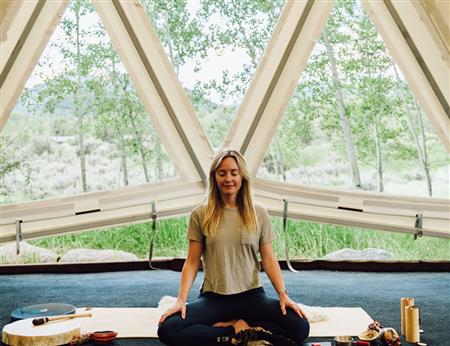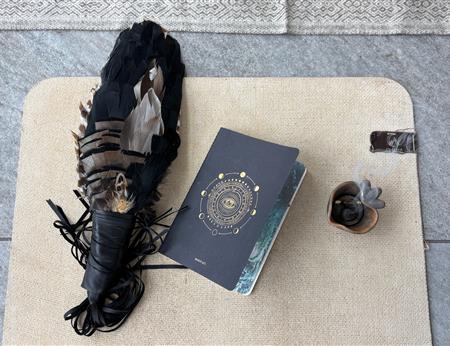Expert Q&A with Nicole Lindstrom:
Unlocking Wellness & Mindfulness in Daily Life
Wellness transcends traditional boundaries; it’s an immersive experience found through nutrition, sleep, exercise, mindfulness, and happiness. Whether you find solace by the fireplace overlooking mountainous views or indulging in an uninterrupted night's sleep with the soothing sounds of the Caribbean Sea, we invite you to choose the experience that brings you bliss and connection. To learn more about how to practice mindfulness within our daily lives, we consulted the expert, Nicole Lindstrom. Nicole is a yoga and meditation teacher and author who specializes in bringing wellness experiences to groups worldwide. Continue reading for tips on how to belong to the moment.

Mindfulness & Mental Well-Being
What are the biggest misconceptions about mindfulness, and how can someone new to the practice get started?
One of the biggest misconceptions about mindfulness is that it’s difficult or requires a certain type of person to do it “correctly.” Many people think, “My mind just doesn’t work like that.” In reality, mindfulness isn’t about stopping thoughts or achieving a perfectly still mind—it’s simply about noticing the present moment.
To get started, you don’t need anything special—you can begin right now. Take three deep, intentional breaths. Notice how the air feels as you inhale, the way your belly and chest expand, and the gentle release as you exhale. What else do you notice? Sensations in your body? The colors, shapes, and textures around you? Mindfulness is about paying attention. The more you practice, the more you’ll discover in each moment.
Are there any simple mindfulness exercises that can be done in under five minutes to feel more present?
The 5-4-3-2-1 Grounding Practice
This simple exercise helps you feel more present by engaging your senses. By the time you finish, you’ll feel more grounded, present, and connected to the moment.
- Notice 5 things you can see – Look around and find five details you might not usually pay attention to: a shadow on the wall, the texture of your clothing, or the way light reflects off a surface.
- Notice 4 things you can feel – Tune into sensations in your body or what’s around you: the warmth of your hands, your feet on the floor, or the fabric of your clothes against your skin.
- Notice 3 things you can hear – Listen closely to sounds in your environment: distant traffic, birds chirping, or the hum of an appliance.
- Notice 2 things you can smell – Take a deep breath and notice any scents, whether strong or subtle: your coffee, fresh air, or a hint of soap on your skin.
- Notice 1 thing you can taste – Focus on any lingering taste in your mouth, sip a drink, or take a mindful bite of food.

Stress & Emotional Balance
What are some of the most effective techniques for managing stress in high-pressure situations?
To be effective in a high-pressure situation, the best thing you can do is ground yourself in your body and clear your mind so you can focus on the task at hand.
- Find your breath: take three deep breaths as slowly and fully as you can.
- Continue until you can count a slow and steady 6 count inhale and 6 count exhale.
- Find your feet: while you continue your 6 count breathing, feel your feet on the ground.
- Lift all 10 toes so you can feel the 4 corners of your feet pressing downwards and your toes and spine lifting upwards.
- Press your weight into the four corners of both feet and notice how it lifts your head taller.
- Relax your shoulders and your toes as you breathe and feel the stability of the ground beneath you.
- Find your palms: clench and unclench your hands.
- Spread your fingers wide, then close them tightly into a fist as many times as you need to find your hands.
- Flick your wrists and fingers to release the tense energy building your body.
- Respond vs react: once your heart rate slows and your head clears, think about how you can best choose to respond to the given situation.
- Notice the discrepancy between how you want to react vs. what would be a more effective response to achieve your desired outcome.
- Choose: the best given response for your ultimate desired outcome.
Reframing perspective: How is this high-pressure situation serving you? What is it asking of you? How can you rise as your best self to best handle the situation? Shift focus from "I have to" to "I get to" to transform stress into motivation.
How can mindfulness help improve emotional resilience and mental clarity?
- Encourages non-reactivity, allowing you to respond rather than react to stress.
- Enhances self-awareness, making it easier to recognize and process emotions.
- Strengthens the ability to stay present, reducing anxiety about the future.

Sleep & Relaxation
Many people struggle with racing thoughts at night—what are your top recommendations for achieving deep, restorative sleep?
Create a wind-down ritual: Dim lights, play soft instrumental music or binaural beats, light candles, read or journal an hour before bed.
Try Sleep Meditations: A guided relaxation practice that shifts the body into deep rest. You can search for practices on youtube and the app - insight timer.
Write To-Do Lists: If you have a lot on your mind, make a to do list of what is important, so your mind can rest knowing that you’ve got it covered and will take care of anything outstanding the next day.
Are there any wellness rituals or bedtime habits that can naturally enhance sleep quality?
- Drink herbal tea like chamomile or valerian root.
- Take a warm bath with magnesium salts.
- Practice gratitude journaling to release lingering stress from the day.
- Use essential oils like lavender to signal relaxation to the brain.
- Put away all of your screens / blue light an hour before you would like to fall asleep.
- Play soft instrumental music or binaural beats. Binaural beats are an auditory illusion created when you listen to two slightly different frequencies in each ear. Your brain perceives a third "beat" at the difference between the two frequencies, which can influence brainwave activity and promote different mental states.
For example:
- Delta waves (0.5-4 Hz) → Deep sleep & relaxation
- Theta waves (4-8 Hz) → Meditation & creativity
- Alpha waves (8-14 Hz) → Calm focus & stress relief
- Beta waves (14-30 Hz) → Alertness & concentration
- Gamma waves (30+ Hz) → Higher cognitive function & insight
Many people use binaural beats for relaxation, meditation, focus, or even sleep. To experience them fully, use stereo headphones, so each ear receives a distinct frequency.

Holistic Wellness & Self-Care
What are some powerful self-care practices that go beyond traditional spa treatments?
- Nature immersion: Forest bathing, barefoot grounding, or sitting by water.
- Sound healing: Use singing bowls, binaural beats, or chanting.
- Creative expression: Painting, dancing, journaling or playing music as a release.
- Digital detox: Unplugging for a few hours or an entire day.
What is an easy breathwork technique anyone can use for instant relaxation?
The "Sigh of Relief" breath: Inhale deeply through the nose, then exhale audibly through the mouth with a long sigh—instantly releases tension. You will notice a big shift in just three breaths and can practice as long as you need to feel your body and mind relax.

Movement & Mind-Body Connection
How does movement, such as yoga or stretching, contribute to overall wellness and stress relief?
- Releases endorphins, reducing stress and improving mood.
- Improves circulation, helping detoxify the body.
- Enhances body awareness, promoting a sense of grounding.
- Encourages rhythmic breathing, naturally calming the nervous system.
What are the best ways to incorporate mindfulness into everyday activities like eating, walking, or working?
- Eating: Chew slowly, savor flavors, engage all senses.
- Walking: Feel each step, notice your breath, observe surroundings without judgment.
- Working: Take intentional pauses.
- Practice chair stretches, deep breathing, and forward folds (stand up, bend your knees and let your head drop down towards the floor grabbing opposite elbows and swaying left to right, rolling slowly up one vertebrae at a time once complete).
- Continue to check in on your posture, resetting as often as needed to keep your spine lifted and your shoulders relaxed.
- Get fresh air by stepping outside for a walk or to just feel the sun and air on your skin for a few minutes.

About Our Expert
Nicole Lindstrom is a yoga and meditation teacher who teaches all over the world. She is the co-author of “WANDERLUST: A Modern Yogi's Guide To Becoming Your Best Self" and founder of GLDMND, guiding individuals and groups to the gold that lies within. From guiding hikes and meditations with Wanderlust to leading global retreats with Yogascapes and Lead with Love, Nicole has an incredible depth of expertise and knowledge in holding space and curating group experiences. She is currently the Yoga and Bespoke Experiences Director at True Nature Healing Arts in Carbondale, CO and actively hosts wellness events at Aspen Meadows Resort throughout the year.
Connect with Nicole: @gldmnd.co | @nicole.lind.strom








